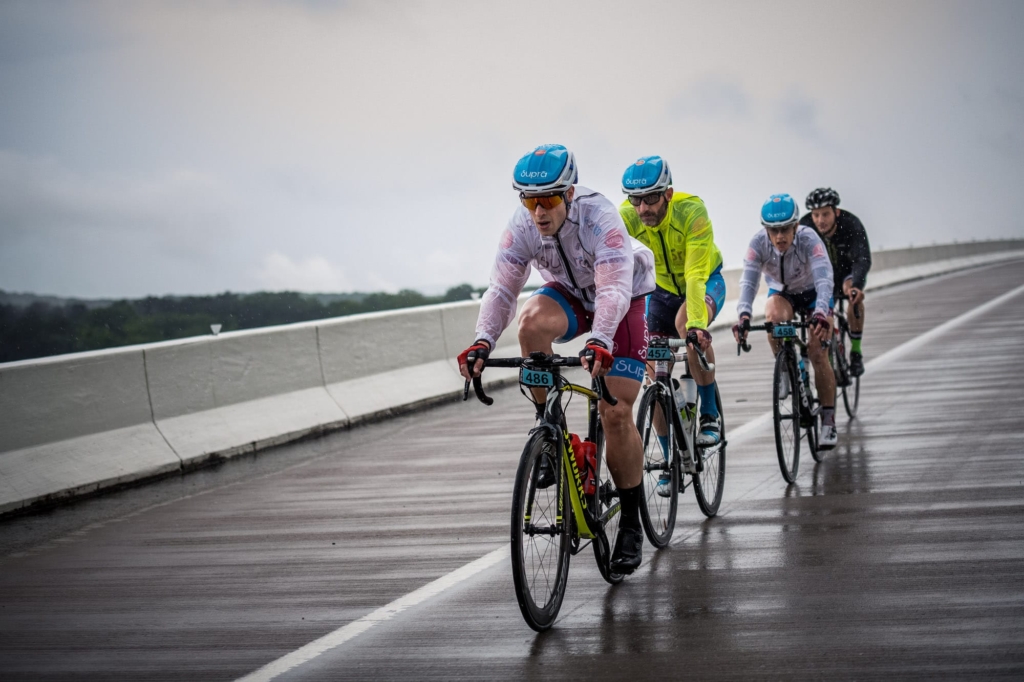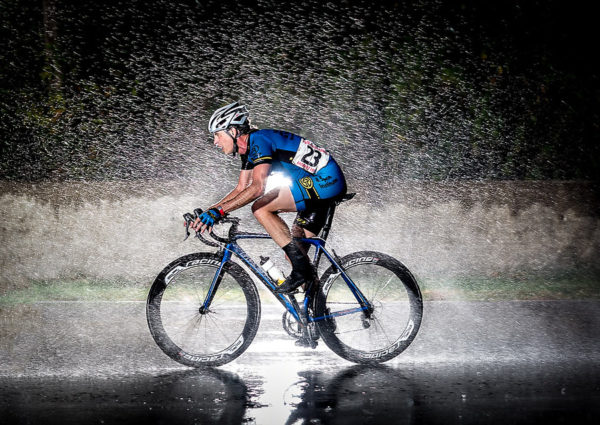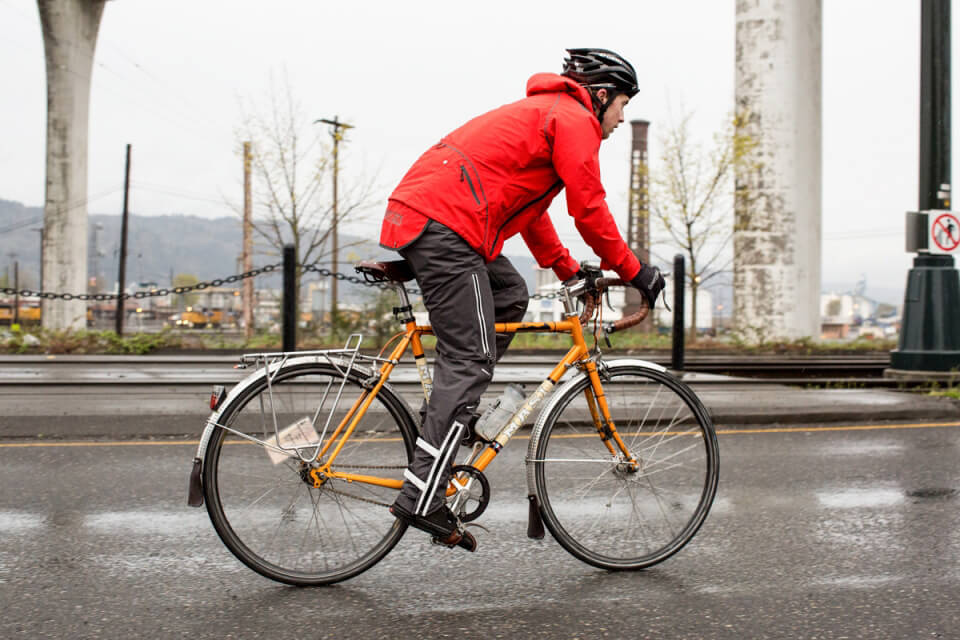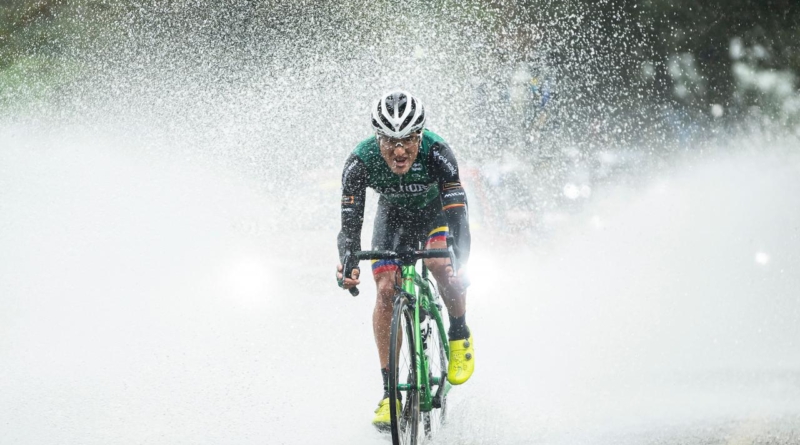7 Tips for How to Bike in the Rain
When it starts raining, it can be a real hassle to hop on your bike. The streets become slippery, the skies turn grey, and the cold droplets splattering on the pavement can be discouraging. However, once you’re on your bike, it can be a fantastic experience commuting, running errands, or even embarking on a weekend excursion.
Reginald “Doc” Wilson, a cyclist and creator of Peace Peloton, hails bikes as a “fantastic multidimensional tool” for both transportation and fitness. Biking around allows for plenty of time to take in your surroundings and enjoy the journey at a relaxed pace, which can make you feel happy and fulfilled.
While most people may not look forward to wet rides, there are ways to make them more manageable and reduce the potential bad effects. Kate Veronneau, a former guide for Thomson Bike Tours, encourages riders to practice riding in the rain to get a better feel for how their bike behaves in such conditions. She advises people to dress appropriately to feel confident and comfortable while riding in the rain.
Here are 7 tips to keep you comfy in the wet…
Keeps you toasty but also allows your skin to breathe

Cycling in the great outdoors can be tough in chilly weather, but don’t let that stop you from enjoying the ride! To stay warm and comfortable, it’s essential to wear clothing that keeps you toasty but still allows your skin to breathe.
The trick is to dress in layers, so try experimenting with various clothing layers to see what works best for you. If you’re heading out on a lengthy trip, you’ll want to choose clothing that allows you to let off some steam every so often. A great combination for wet weather is a thin base layer, a rain jacket, breathable cycling tights, and waterproof leggings. Check out our list of the Best Cycling Jackets to find a model our editors recommend.
To protect your ears from the wind, wear a headband under your helmet. If you’re only going on a short, level journey of about 15 minutes, you may not need much ventilation. You could even wear a warmer sweater or base layer under your raincoat for added warmth. If you want more ventilation without taking off your jacket, choose one with pit zips for venting.
Your fingertips are the first to get chilly when cycling, so be sure to wear a pair of waterproof, insulated gloves. Look for gloves that you can also use when skiing or kayaking for added versatility.
Cycling shoes are often narrow in the forefoot and heel, so if you want to wear thick wool socks, you may need to order a half size higher. Choose between clipless or flat pedals based on your preference, but ensure that the bottoms of your shoes have good grip to make dismounting on busy streets easier. Don’t forget to protect your feet from the elements by covering your bike shoes with windproof and waterproof cycling shoe coverings. For even more warmth on chilly days, try wearing foot warmers under your socks.
Prevent Splash from mudguards or fenders

Riding in wet conditions can be a real pain, but there’s an easy way to prevent water from splashing all over you: use mudguards or fenders!
These may not be the most stylish accessories for your bike, and they can even be a bit noisy, but trust us, they’re necessary. A good set of mudguards can prevent dirty water from spraying up your legs and back while you ride, keeping you dry and comfortable.
Even if it’s not currently raining, the roads can still be slippery, and your bike’s wheels can flick up mud and water, leaving you soaked and shivering. But fear not! You can boost your defenses by adding a flap to the front of your mudguard, which will give you even more protection against the elements.
So, if you’re planning on cycling in wet conditions, don’t forget to invest in some mudguards or fenders. You’ll be grateful for the added protection, and you won’t have to worry about getting drenched while you ride!
Itinerary and Ride Strategies

Cycling in the rain can be tricky, but with the right itinerary and ride strategies, you can stay safe and enjoy the ride!
First of all, it’s essential to adapt to the changing road conditions as the rain falls. As Brown warns, the road surface can be dangerous right after it starts raining. If you’re worried about road safety, Wilson recommends taking a gravel path instead of a road during a downpour. Not only does gravel have excellent drainage, but the trail is likely to be less crowded. Plus, you won’t have to worry about cars spraying you with water!
It’s also crucial to keep an eye out for hidden hazards like maintenance hole covers, storm drains, painted surfaces, and damp leaves, all of which become extremely hazardous when wet. Try to avoid braking on top of them if possible, and steer clear of puddles that could conceal deep potholes.
Braking can be tricky in wet weather, so be ready to stop earlier than you would in dry conditions. Brown explains that most wheels require one full rotation of the wheel with the brakes engaged to squeegee the water off the braking surface and start braking. So, be sure to leave enough stopping distance to avoid accidents.
To stay visible to motorists, Wilson of Peace Peloton suggests maintaining a position in the center or right third of the outer lane. It may seem counterintuitive, but drivers are more likely to leave you room if you’re in the right lane of traffic rather than the far shoulder. This also helps you avoid colliding with a parked vehicle on the shoulder.
By following these itinerary and ride strategies, you can enjoy a safe and comfortable cycling experience in the rain. Don’t let the weather stop you from getting out on your bike and exploring!
Check your tires and reduce the pressure

Cycling in the rain can be a challenge, but with the right preparation and gear, it can also be an enjoyable experience. One important aspect of preparing for cycling in the rain is checking your tire pressure and reducing it accordingly.
Why is tire pressure important for biking in the rain? When roads are wet, they are more slippery and unpredictable, making it harder to control your bike. Lower tire pressure can improve traction and give you more stability on wet roads. It also allows for more surface contact with the road, which can increase control.
Reducing tire pressure can also help to prevent hydroplaning. Hydroplaning happens when a layer of water forms between the tire and the road surface, causing the tire to lose contact with the road. This can be especially dangerous while cycling, as it can cause you to lose control and potentially lead to an accident.
So, how do you check your tire pressure and reduce it for cycling in the rain? Firstly, it’s important to know what the recommended tire pressure is for your specific bike and tires. This information can usually be found on the sidewall of your tire or in the owner’s manual for your bike.
To check your tire pressure, you’ll need a tire pressure gauge. Simply remove the valve cap on your tire and attach the gauge to the valve stem. The gauge will give you a reading of the current pressure in your tire.
To reduce your tire pressure, simply use a pump with a pressure gauge to let out air until it reaches the recommended pressure for cycling in the rain. For example, if the recommended pressure for your tire is 100 PSI, you may want to reduce it to around 80 PSI for better traction in wet conditions.
It’s important to note that reducing tire pressure can also affect your speed and handling, so be sure to experiment with different pressures and find the right balance for your needs.
Use chain degreaser
One of the most important things to consider when cycling in the rain is the health of your bike chain. This is where chain degreaser comes in.
Why is chain degreaser important for biking in the rain? Rain and mud can accumulate on your bike chain, causing it to rust and wear down over time. Chain degreaser helps to remove dirt and grime from your chain, preventing rust and prolonging the life of your bike.
Using chain degreaser can also help keep your bike running smoothly. When your chain is dirty, it can cause your bike to shift poorly or make unusual noises. A clean chain means a more efficient and quiet ride.
When it comes to choosing a chain degreaser, there are several options available on the market. Some popular brands include WD-40 Bike Chain Degreaser, Finish Line Citrus Degreaser, and Park Tool CB-4 Bio ChainBrite. Look for a degreaser that is specifically designed for bike chains and is safe to use on all types of bikes.
How often should you use chain degreaser? It depends on how often you ride and the conditions you ride in. If you’re a frequent rider in wet conditions, you may want to use chain degreaser every 100-200 miles or once a month. If you ride less frequently, you may only need to use it a few times a year.
To use chain degreaser, simply apply it to your chain and let it sit for a few minutes. Then, use a brush or rag to remove any dirt or grime. Rinse your chain with water and let it dry before applying chain lubricant.
Use lights
Why are lights important for biking in the rain? Rain and fog can reduce visibility for both cyclists and drivers on the road. Lights can help make cyclists more visible to drivers and pedestrians, reducing the risk of accidents. They can also help illuminate the road ahead, making it easier for cyclists to navigate through the rain.
When it comes to choosing lights for biking in the rain, there are several options available on the market. Some popular brands include NiteRider, Cygolite, and Knog. Look for lights that are specifically designed for biking and are waterproof or water-resistant. LED lights are a great option, as they are bright, energy-efficient, and long-lasting.
To use lights while biking in the rain, there are a few things to keep in mind. First, make sure your lights are fully charged or have fresh batteries. It’s also important to position your lights correctly. The front light should be mounted on your handlebars or helmet, and the rear light should be mounted on your seat post or rear rack. Make sure your lights are angled correctly to maximize visibility.
It’s also important to use lights during the day in rainy conditions, as visibility can be just as poor as at night. In fact, many bike lights have a daytime flashing mode specifically designed to increase visibility during the day.
Finally, be mindful of the battery life of your lights and carry backup batteries or a charging cable in case your lights run out of power during your ride.
In conclusion, using lights while biking in the rain is an important safety measure to reduce the risk of accidents and improve visibility. Look for lights that are specifically designed for biking and are waterproof or water-resistant, and position them correctly on your bike. Use your lights during the day and carry backup batteries or a charging cable to ensure your safety during your ride. Happy cycling!
Don’t always hide from the rain
Cycling in the rain may not be everyone’s cup of tea, but there are plenty of reasons why you shouldn’t always hide from the rain. Biking in the rain can be a great way to challenge yourself, improve your cycling skills, and experience nature in a new way.
Why is it important to still get out and bike in the rain? For one, it can be a great way to push yourself outside of your comfort zone. Cycling in the rain requires a different set of skills and techniques than cycling in dry conditions, and it can help you become a more versatile and confident rider.
Additionally, biking in the rain can be a fun and invigorating experience. The sights, sounds, and smells of the rain can create a unique and memorable ride, and you may even have the roads to yourself as other cyclists opt to stay inside.
To make biking in the rain more enjoyable, there are a few things you can do. One option is to use a turbo trainer, which allows you to cycle indoors and still get a good workout. This can be a great way to stay in shape and maintain your cycling routine even on the rainiest of days.
Another option is to change your mindset. Instead of viewing rain as a negative, try to embrace it as part of the cycling experience. Dress appropriately, bring a waterproof bag for your belongings, and focus on the positives of cycling in the rain, such as the quietness of the roads and the fresh air.
It’s also important to be prepared when biking in the rain. Wear appropriate clothing, such as waterproof jackets and pants, and consider using fenders or mudguards to protect yourself from splashing water. Check your bike’s brakes and tires before heading out, and be extra cautious on slippery roads.
In conclusion
In conclusion, cycling in the rain can be a challenging but rewarding experience for cyclists. While it may require additional safety precautions and gear, such as using lights, reducing tire pressure, and using chain degreaser, there are many benefits to biking in the rain, such as pushing yourself outside of your comfort zone, improving your skills, and experiencing nature in a new way. Additionally, with specific tips such as using a turbo trainer, changing your mindset, and being prepared for wet conditions, you can make cycling in the rain more enjoyable. So don’t always hide from the rain, embrace the challenge and enjoy the ride!
